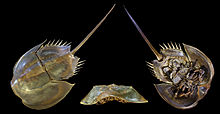Xiphosura
| Xiphosura Temporal range: Silurian–Recent |
|
|---|---|
 |
|
| Limulus polyphemus | |
| Scientific classification | |
| Kingdom: | Animalia |
| Phylum: | Arthropoda |
| Subphylum: | Chelicerata |
| Class: |
Xiphosura Latreille, 1802 |
| Order: |
Xiphosurida Latreille, 1802 |
| Subdivisions | |
|
†Suborder Synziphosurida Suborder Xiphosurida
|
|
†Suborder Synziphosurida
Suborder Xiphosurida
The Xiphosura are an order of marine merostome chelicerates that includes a large number of extinct lineages and only four extant species in the family Limulidae, which includes the horseshoe crabs. The group has hardly changed in millions of years; the modern horseshoe crabs look almost identical to prehistoric genera such as the Jurassic Mesolimulus, and are considered to be living fossils. The most notable difference between ancient and modern forms is that the abdominal segments in present species are fused into a single unit in adults.
Xiphosura were traditionally placed in the class Merostomata, although this term was intended to encompass also the eurypterids, whence it denoted what is now known to be an unnatural (paraphyletic) group (although this is a grouping recovered in some recent cladistic analyses). Although the name Merostomata is still seen in textbooks, without reference to the Eurypterida, some have urged that this usage should be discouraged. The Merostomata label originally did not include Eurypterida, although they were added in as a better understanding of the extinct group evolved (see Merostomata for additional details).
Modern xiphosurans reach up to 60 cm (24 in) in adult length, but the Paleozoic species were often far smaller, some as small as 1 to 3 cm (0.39 to 1.18 in) long.
Their bodies are covered with a tough cuticle, but do not contain any crystalline biominerals, and are divided into an anterior prosoma and a posterior opisthosoma, or abdomen. The upper surface of the prosoma is covered by a semicircular carapace, while the underside bears five pairs of walking legs and a pair of pincer-like chelicerae. The mouth is located below the forward tip of the carapace, and lies behind a lip-like structure called the labrum.
...
Wikipedia
